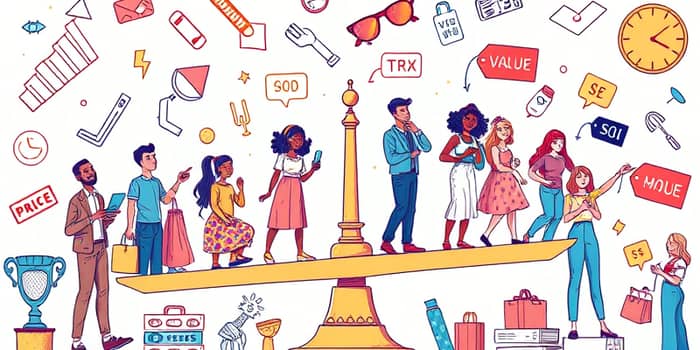
As inflation continues to shape the U.S. economy in 2025, consumer behavior is undergoing a profound transformation. From seeking value-conscious deals to prioritizing experiences over material possessions, Americans are adapting in creative ways.
Understanding these shifts can help businesses, policymakers, and individuals navigate an evolving landscape where every dollar spent reflects strategic choices and changing priorities.
The past year has witnessed persistent though cooling inflation in the United States. The Consumer Price Index (CPI) rose 2.4% over the 12 months ending May 2025, while the Personal Consumption Expenditures (PCE) price index climbed 2.3% in May, up from 2.1% in April. Core prices, excluding volatile food and energy, accelerated by 2.7% year-over-year.
Federal Reserve Chair Jerome Powell warned that new tariffs could reignite inflationary pressures. Although interest rates remain unchanged for now, markets anticipate a 50-basis-point cut in late 2025, with long-term rates lingering at elevated levels. This tight monetary policy environment continues to influence borrowing costs and consumer credit availability.
On the labor front, unemployment remains low, and job growth has been steady. However, wage gains have not kept pace with spending increases, leading to a slight drop in real incomes in May 2025. Consumer sentiment has dipped, with the University of Michigan index falling 18.2% between December 2024 and June 2025. Roughly half of Americans still cite rising prices as their primary concern, fueling cautious spending behavior.
Real personal consumption expenditures (PCE) grew just 1.2% annualized in Q1 2025, a sharp deceleration from 4% in Q4 2024. In May, consumer spending fell by 0.1%—its first monthly decline since January—as households front-loaded purchases before anticipated tariffs, then paused.
Forecasters predict spending growth of only 1.4% in 2025 and 1.5% in 2026. Many analysts expect consumer outlays to remain subdued heading into next year, constrained by tighter credit conditions and lingering inflation fears.
Spending patterns have diverged across categories:
Overall, expenditures on material goods have softened while spending on experiences and services retains momentum, reflecting a growing desire for intangible value.
Inflation has prompted an intensification of trading down and value-seeking behaviors. According to global surveys, 79% of consumers are trading down, but not just by purchasing cheaper items or visiting discount stores.
Instead, more than half actively hunt for deals on every purchase. In the U.S., 49% of consumers intend to delay purchases over the next three months, while 58% prefer allocating spending to experiences rather than physical goods—14 percentage points above the global average.
Category substitution has emerged as a notable trend: one-third of households trade down in one area (for example, switching to private-label groceries) to splurge selectively on nonessentials like streaming subscriptions or weekend getaways. Remarkably, one-fifth of consumers are willing to cut back on essentials to afford indulgences in discretionary categories, a testament to evolving priorities despite inflation concerns.
The burden of inflation and higher borrowing costs has fallen unevenly. Lower-income households face steeper challenges as rents, housing prices, and essential spending absorb larger portions of their budgets. Rising auto loan and credit card delinquencies suggest some segments are straining to use debt to maintain spending levels.
Gen Z consumers report heightened financial stress, drawing down savings more rapidly and experiencing fewer income gains compared to older cohorts. As a result, Buy-Now-Pay-Later (BNPL) options have gained traction: 13% of Millennials and 10% of Gen Zers used BNPL in recent months, seeking flexible payment solutions to manage cash flow.
Discount and wholesale channels have seen growing popularity across income and age brackets. Eighty percent of U.S. Gen Z shoppers visited a wholesaler in the past month, while traditional retailers have responded by ramping up promotional activity and emphasizing cost-saving messaging.
Brands that highlight affordability and long-term value are resonating. Flexible payment options, clear promotions, and durable product guarantees have become essential components of the marketing mix. Retailers are also enhancing loyalty programs and personalized offers to retain budget-conscious consumers.
Decisions are becoming more selective. While big-ticket discretionary items such as garden furniture and fitness machines have seen steep declines, spending on travel, dining out, and digital experiences continues to hold appeal. Americans are willing to invest in moments that create lasting memories.
Internationally, consumers share similar concerns: 62% cite inflation as a top worry, and 50% hold negative views of their national economies. Trading down, deal-seeking, and purchase delays are evident worldwide, with many markets experiencing shifts in channel preferences and value-driven shopping behaviors.
However, cultural differences shape the balance between goods and services. In some regions, services remain a larger share of household budgets, while in others, durable goods continue to attract spending once price pressures ease.
By adapting to these evolving consumer spending patterns, businesses can thrive even in an environment shaped by inflationary pressures. Individuals benefit by making informed choices that balance prudent budgeting with enriching experiences. Ultimately, the way forward lies in harmonizing value and meaning, ensuring every purchase aligns with both financial goals and life’s memorable moments.
References













